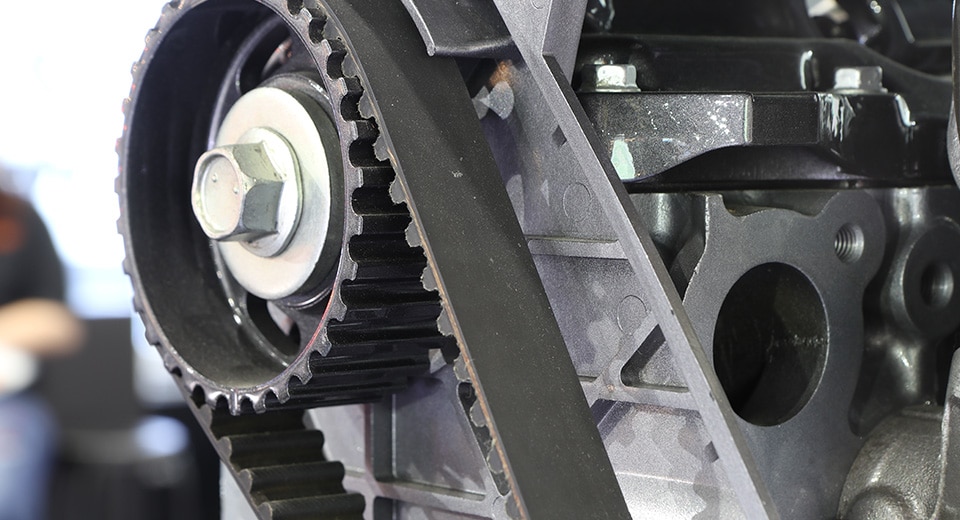
When To Replace Your Timing Belt & Why It's Important
Did you know that there's one rubber belt within your vehicle that's responsible for "conducting the whole orchestra" in your engine? Timing Belts don't get talked about a whole lot because they're tough, concealed, and don't need attention very often. However, if it fails, it will bring your road trip to a screeching halt.
The West Michigan adventuring season is about to begin, and making sure your vehicle is ready is key. Below, we'll explain what a timing belt is, what it does, and why it pays dividends to have it replaced on schedule rather than waiting for it to fail.
What Is A Timing Belt and What Does It Do?
An internal combustion engine has many, many moving parts, and some of them are delicate. A timing belt keeps them all in sync with each other as the engine turns, making sure each stage of combustion is happening exactly when it's supposed to. This not only ensures your engine runs efficiently, but that parts don't become bent or damaged from colliding with one another.
A timing belt is usually made of rubber reinforced with steel or strong fibers and is obscured by a cover or shroud. If you're looking for it, it's not too difficult to find - it will be situated on the end of your engine and in most cases, right next to the water pump. If you remove the shroud, you'll see it wrapped around the ends of the camshaft and crankshaft, with teeth on the inside. This is what keeps the timing between the two.
Some older and performance vehicles will have a timing chain instead of a rubber belt (like a bike chain.) These are stronger but much noisier than their rubber counterparts, so rubber is more common.
How Do I Know When My Timing Belt Needs To Be Replaced?
Since timing belts are so critical to your vehicle and require tools to even look at to check, we recommend you have yours inspected every 60,000 miles. Your owner's manual will make a recommendation, sometimes as long as every 120,000 miles, but bear in mind that extreme temperatures, heavy acceleration, and stop-and-go traffic will shorten the life of your timing belt too.
The most direct way to check your timing belt is to remove the shroud if possible and inspect it. The belt should be free from cracks or splits, deflect roughly 1/4 to 1/2 inch when pressed with your finger, and you shouldn't be able to see the steel or fiber reinforcements inside the belt.
NOTE: Unless you have extensive experience with auto repair, NEVER remove or adjust the timing belt. If either the camshaft or crankshaft becomes out of sync, your engine will likely become permanently damaged as a result.
In lieu of looking at the belt, you can also keep an eye or ear out for these tell-tale signs your timing belt may need to be replaced:
- Your vehicle feels sluggish
- You've had issues with misfires, possibly due to faulty spark plugs or ignition coils
- You hear squealing or clicking from the front of the engine (not from the serpentine or accessory belt)
Another compelling reason to have your timing belt inspected is if you've purchased an older Used Vehicle and the seller didn't give you proof it was inspected or replaced at the recommended time.
When a professional shop like the Borgman Service Center replaces your timing belt, the water pump is usually replaced at the same time. This is because the two parts are in close proximity to one another, cause extensive if they fail, and have similar lifecycles. In fact, most DIY timing belt kits include a water pump for the above reasons. Water pumps circulate coolant throughout your engine, so it's not a part you should overlook. While replacing both makes for a slightly higher repair bill, installing both at once saves on labor costs and means less time in the shop.
What Happens If My Timing Belt Fails?
When your timing belt is near failing, your engine isn't going to be nearly as efficient as it should be. You'll hear squealing or clicking noises, notice a significant drop in power, and rough running and idling. If this is the case, we recommend having it towed to the Borgman Service Center as soon as possible.
Most of the time, however, you'll get little to no warning before the belt breaks. In this unfortunate instance, your vehicle will immediately lose all engine power, and significant, catastrophic damage will likely occur. Losing power like this is not only a costly endeavor to repair, but is incredibly dangerous for you and other motorists.
Engine components typically damaged by a failed timing belt include but are not limited to rods, valves, the camshaft and crankshaft, and pistons. A full rebuild is likely going to be more expensive than having a brand new engine installed, making this a very costly repair.

Trust The Experts At The Borgman Service Center To Keep You Moving
If it's time to have your timing belt or any part of your vehicle inspected by a pro, turn to the experts at the Borgman Service Center in Grand Rapids, MI. Our highly-trained and friendly staff will listen to all of your concerns, and make sure your vehicle's recommended maintenance is performed on time and correctly.Need to make an appointment? Use our easy Online Scheduler to plan your visit, then check out our Service Coupons for all the latest offers and rebates. If you have any questions, please feel free to Contact Us! Come see why we're the Best in the West!